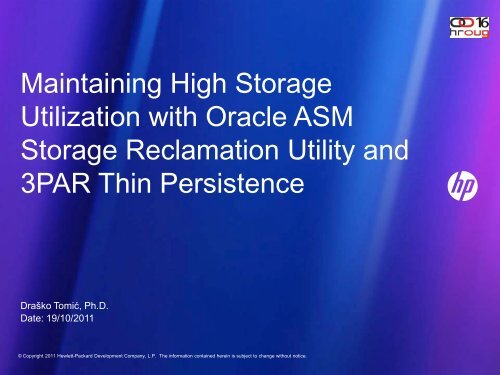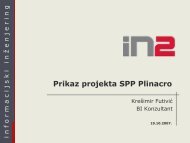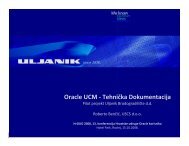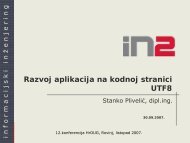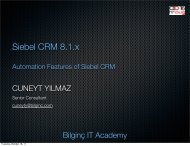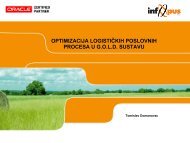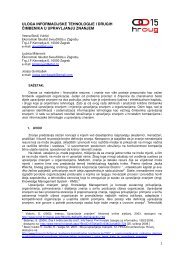3PAR Thin Provisioning - HrOUG
3PAR Thin Provisioning - HrOUG
3PAR Thin Provisioning - HrOUG
Create successful ePaper yourself
Turn your PDF publications into a flip-book with our unique Google optimized e-Paper software.
Maintaining High Storage<br />
Utilization with Oracle ASM<br />
Storage Reclamation Utility and<br />
<strong>3PAR</strong> <strong>Thin</strong> Persistence<br />
Draško Tomić, Ph.D.<br />
Date: 19/10/2011<br />
© Copyright 2011 Hewlett-Packard Development Company, L.P. The information contained herein is subject to change without notice.
Problem: Preserving High Storage<br />
Utilization Over Time<br />
Beginning in 2004, Oracle and <strong>3PAR</strong><br />
teamed together to enable highperformance<br />
Oracle 10g (and later 11g)<br />
databases to be deployed with costefficient<br />
thin provisioned storage for a<br />
dramatic increase in disk utilization,<br />
resulting in up to 50% less wasted storage<br />
capacity as compared to using Oracle<br />
databases with traditional storage arrays.<br />
© Copyright 2011 Hewlett-Packard Development Company, L.P. The information contained herein is subject to change without notice.
Enabling technologies for this combined<br />
Oracle and <strong>3PAR</strong> solution<br />
Oracle Autoextend – Oracle has actively supported storage vendors’<br />
thin provisioning capabilities with a database feature known as<br />
autoextend. Autoextend is to databases as thin provisioning is to storage.<br />
As applications add new data to database tables and additional space is<br />
needed, autoextend will automatically grow the tablespace in size.<br />
Accordingly, the storage array would automatically allocate physical<br />
storage to support the tablespace growth.<br />
© Copyright 2011 Hewlett-Packard Development Company, L.P. The information contained herein is subject to change without notice.
Enabling technologies for this combined<br />
Oracle and <strong>3PAR</strong> solution<br />
Oracle Automatic Storage Management (ASM) – A purpose-built file<br />
system and volume manager integrated in Oracle databases. ASM<br />
dramatically simplifies database file management and storage<br />
administration. Oracle database deployment with thin provisioned<br />
storage was first tested using ASM.<br />
© Copyright 2011 Hewlett-Packard Development Company, L.P. The information contained herein is subject to change without notice.
Enabling technologies for this combined<br />
Oracle and <strong>3PAR</strong> solution<br />
<strong>3PAR</strong> <strong>Thin</strong> <strong>Provisioning</strong> – A green storage technology that dramatically<br />
cuts capacity, energy, and related costs while substantially alleviating<br />
storage and system administration overhead. Capacity is dedicated and<br />
configured autonomically and in small increments from a single,<br />
reservationless, comprehensively scalable reservoir, so storage is<br />
provisioned automatically, efficiently, and on an as-needed basis.<br />
© Copyright 2011 Hewlett-Packard Development Company, L.P. The information contained herein is subject to change without notice.
In an ideal world, once the storage for an Oracle database starts thin,<br />
tt should remain thin.<br />
But, that is often not the case.<br />
Over the Oracle database lifecycle, the utilization of allocated storage capacity<br />
in a thin provisioned volume can decrease as changes are made to the<br />
database through common operations such as:<br />
• Dropping of a tablespace or database upon deletion of transient data<br />
• Resizing of an Oracle datafile upon shrinking a tablespace<br />
• Addition of new disks to an ASM disk group to accommodate growth or load<br />
balance performance<br />
© Copyright 2011 Hewlett-Packard Development Company, L.P. The information contained herein is subject to change without notice.
These changes result in the creation of unused ASM disk space that can<br />
build up over time to account for up to 50% of the total storage capacity<br />
provisioned to Oracle databases.<br />
This space is available for reuse within ASM, but, in the absence of a<br />
control communication protocol between applications/file systems and block<br />
storage, the storage array is unable to distinguish between capacity<br />
associated with deleted data and valid data.<br />
Therefore, the unused capacity remains allocated and in use within the<br />
storage volume(s) on the storage array. The end result is that the storage<br />
utilization falls below desirable levels.<br />
© Copyright 2011 Hewlett-Packard Development Company, L.P. The information contained herein is subject to change without notice.
Solution: Online, Non-Disruptive Space Reclamation for Oracle<br />
This extension of storage efficiency is enabled by two recent innovations:<br />
• Oracle ASM Storage Reclamation Utility (ASRU) – Oracle ASRU is a new utility that extends<br />
Oracle’s support of <strong>3PAR</strong> Utility Storage with <strong>Thin</strong> <strong>Provisioning</strong> by enabling space reclamation.<br />
Oracle ASRU compacts the ASM disks, writes zeroes to the free space, and resizes the ASM disks to<br />
original size with a single command, online and non-disruptively.<br />
• <strong>3PAR</strong> <strong>Thin</strong> Persistence – <strong>3PAR</strong> <strong>Thin</strong> Persistence software detects zero writes and eliminates the<br />
capacity associated with free space in thin provisioned volumes—simply, quickly, and without<br />
disruption. <strong>3PAR</strong> <strong>Thin</strong> Persistence leverages the unique, built-in, zero-detection capabilities of the<br />
<strong>3PAR</strong> Gen3 ASIC within all <strong>3PAR</strong> InServ Storage Server models with <strong>Thin</strong> Built In. Unlike<br />
alternative CPU-based zero-detection approaches that are slow and disruptive, <strong>3PAR</strong>’s revolutionary<br />
hardware capability, built right into the Gen3 ASIC, provides an efficient, silicon-based, zerodetection<br />
mechanism to identify the unused space—quickly and without performance impact.<br />
Subsequently, the virtualization mapping capabilities of <strong>3PAR</strong> <strong>Thin</strong> Engine—built into the <strong>3PAR</strong><br />
InForm® Operating System—remap the storage volume without the unnecessary bulk. Together,<br />
<strong>3PAR</strong> <strong>Thin</strong> Persistence software and the <strong>3PAR</strong> Gen3 ASIC deliver fast, online reclamation of unused<br />
storage capacity.<br />
© Copyright 2011 Hewlett-Packard Development Company, L.P. The information contained herein is subject to change without notice.
Overview of ASRU Operation<br />
Oracle ASM Storage Reclamation Utility (ASRU) is a stand-alone utility used<br />
to reclaim storage in an ASM disk group that was previously allocated but is<br />
no longer in use. The ASRU utility, a Perl script, accepts the name of the disk<br />
group for which space should be reclaimed. When executed, it writes blocks<br />
of zeros to regions on ASM disks where space is currently unallocated. The<br />
<strong>3PAR</strong> InServ Storage Server, using the zero-detect capability of the Gen3<br />
ASIC, will detect these zero blocks and reclaim any corresponding physical<br />
storage.<br />
The administrator invokes the ASRU utility, which<br />
operates in three phases:<br />
© Copyright 2011 Hewlett-Packard Development Company, L.P. The information contained herein is subject to change without notice.
• Compaction Phase – In this phase, ASRU logically resizes the disks downward<br />
such that the amount of space in the disk group is at the allocated amount of file<br />
space in the disk group, plus a reserve capacity.<br />
The default value for the reserve amount is 25 percent; however, the reserve value<br />
is a settable option in the utility.<br />
The resize operation of the disks is logical to ASM and has no effect on the physical<br />
disks.<br />
The effect of the resize operation is that file data in the ASM disk group is<br />
compressed near the beginning of the disks which is accomplished by an ASM<br />
rebalance of the disk group.<br />
The utility uses the appropriate database V$ table to determine the current allocated<br />
size of the disk group.<br />
The next phase does not begin until the ASM rebalance for the disk group has<br />
completed and verified as complete. (Although this phase invokes an ASM<br />
rebalance, it does not perform a complete extent relocation operation, just the<br />
compaction portion of the rebalance operation.<br />
Therefore, it should minimally impact the environment.)<br />
© Copyright 2011 Hewlett-Packard Development Company, L.P. The information contained herein is subject to change without notice.
• Deallocation Phase – During this phase, ASRU writes zeros above the region<br />
where the ASM disks have been resized.<br />
The ASRU utility invokes another script called zerofill that does the writing of<br />
zeros.<br />
It is during this deallocation phase that the zero-detect algorithm within the<br />
<strong>3PAR</strong> <strong>Thin</strong> Engine will return the freed storage blocks to the free storage pool.<br />
© Copyright 2011 Hewlett-Packard Development Company, L.P. The information contained herein is subject to change without notice.
• Expansion Phase – In the final phase, all of the ASM disks will be resized<br />
to their original size as determined when ASRU was started. This resize<br />
operation is a logical resize of the disks with respect to ASM and does not<br />
result in a reorganization of file data in the disk group.<br />
© Copyright 2011 Hewlett-Packard Development Company, L.P. The information contained herein is subject to change without notice.
When to Use ASRU to Reclaim Storage<br />
Storage reclamation should be considered after several different types of events:<br />
• Dropping one or more databases<br />
• Dropping one or more tablespaces<br />
• Adding one or more new volumes to an ASM Disk Group, which triggers an ASM<br />
rebalance to move a subset of the data from the old volumes to the new volume(s).<br />
The storage released from the old volumes is a candidate for reclamation.<br />
© Copyright 2011 Hewlett-Packard Development Company, L.P. The information contained herein is subject to change without notice.
To determine whether storage reclamation will be beneficial after one of<br />
these operations, it is important to consider the effect of the reserve<br />
maintained by ASRU when the utility reduces the size of the disk group<br />
during the compaction phase. The temporarily reduced size is equal to the<br />
allocated space plus a reserve which allows active databases to grow<br />
during the reclamation process; the default reserve is 25% of the allocated<br />
storage. Storage reclamation is likely to be beneficial if the amount of<br />
allocated physical storage significantly exceeds the amount of storage<br />
allocated within ASM plus the reserve.<br />
cli% showvv - showcols \<br />
© Copyright 2011 Hewlett-Packard Development Company, L.P. The information contained herein is subject to change without notice.
© Copyright 2011 Hewlett-Packard Development Company, L.P. The information contained herein is subject to change without notice.
<strong>3PAR</strong> Hardware Architecture: Scale without<br />
Tradeoffs<br />
<strong>3PAR</strong> InSpire® F-Series<br />
Architecture<br />
A finely, massively, and<br />
automatically load<br />
balanced cluster<br />
<strong>3PAR</strong> InSpire® T-Series<br />
Architecture<br />
<strong>3PAR</strong><br />
ASIC<br />
F200,<br />
F400<br />
Legend<br />
Host Connectivity<br />
Data Cache<br />
Disk Connectivity<br />
T400,<br />
T800<br />
Passive Backplane<br />
© Copyright 2011 Hewlett-Packard Development Company, L.P. The information contained herein is subject to change without notice.
<strong>3PAR</strong> Hardware Architecture:<br />
Scale without Tradeoffs<br />
Traditional Controllers<br />
Mesh-Active Controllers<br />
– Each volume is active on<br />
only one controller – really<br />
“Active-Passive”<br />
– Volume is restricted to<br />
drives behind a single<br />
controller<br />
– Manual planning and load<br />
balancing for each<br />
controller<br />
– Each volume is active on<br />
all controllers – true<br />
“Active-Active”<br />
– Volume is evenly spread<br />
across all resources<br />
• drives<br />
• controllers<br />
• cache<br />
• IO<br />
– Autonomically provisioned<br />
– Cache Coherent<br />
Controllers<br />
– Cache not necessarily<br />
shared<br />
© Copyright 2011 Hewlett-Packard Development Company, L.P. The information contained herein is subject to change without notice.
RAID efficiency & resiliency without tradeoffs<br />
Fast RAID 5 and 6<br />
Key enablers:<br />
– Massive parallelization<br />
– <strong>3PAR</strong> ASIC for XOR calculations<br />
Tested by:<br />
© Copyright 2011 Hewlett-Packard Development Company, L.P. The information contained herein is subject to change without notice.
Mixed Workload:<br />
SQL Server Tests from MSFT<br />
Test Configuration<br />
240 Drives<br />
OLTP<br />
240 Drives<br />
Mixed (OLTP + Sequential)<br />
© Copyright 2011 Hewlett-Packard Development Company, L.P. The information contained herein is subject to change without notice.
Overview <strong>3PAR</strong> <strong>Thin</strong> Technologies<br />
<strong>Thin</strong> Conversion<br />
<strong>Thin</strong> Persistence<br />
– Rapid migration from Fat to <strong>Thin</strong> allows<br />
for easy conversion from legacy storage<br />
environments at line speeds<br />
– Preserve service levels without<br />
disruption or performance impact during<br />
migrations<br />
– Reduce storage capacity costs by<br />
allowing “thin” volumes to stay “thin”<br />
<strong>Thin</strong> Copy Reclamation<br />
– Reduce storage capacity costs by<br />
reclaiming storage capacity that is<br />
deleted but still “locked” in allocated<br />
space<br />
© Copyright 2011 Hewlett-Packard Development Company, L.P. The information contained herein is subject to change without notice.
Get <strong>Thin</strong>: <strong>3PAR</strong> <strong>Thin</strong> Conversion<br />
• <strong>Thin</strong> your online SAN storage<br />
up to 75%<br />
• A practical and effective solution to<br />
eliminate costs associated with:<br />
• Storage arrays and capacity<br />
• Software licensing and support<br />
• Power, cooling, and floor space<br />
• Unique <strong>3PAR</strong> Gen3 ASIC with built-in<br />
zero detection delivers:<br />
• Simplicity and speed – eliminate the time &<br />
complexity of getting thin<br />
• Choice - open and heterogeneous migrations<br />
for any-to-<strong>3PAR</strong> migrations<br />
• Preserved service levels – high performance<br />
during migrations<br />
Gen3 ASIC<br />
0000<br />
0000<br />
0000<br />
Before<br />
Fast<br />
After<br />
© Copyright 2011 Hewlett-Packard Development Company, L.P. The information contained herein is subject to change without notice.
GEN3 ASIC CIRCUIT DIAGRAM<br />
© Copyright 2011 Hewlett-Packard Development Company, L.P. The information contained herein is subject to change without notice.
HP Education Services – <strong>3PAR</strong><br />
HP <strong>3PAR</strong> Managing <strong>3PAR</strong> Disk Arrays<br />
Category: Storage<br />
Course length: 3 days<br />
Level: Beginner/Intermediate<br />
Delivery method: classroom and RAIL (Remotely Assisted Instructional<br />
Learning = combines the best of classroom training with the best of online<br />
training: without the travel and with reduced ‘out-of-office’ time.<br />
You attend our best-in-class instructor-led training from wherever you are:<br />
home, office, anywhere)<br />
This 3 day IDL overviews <strong>3PAR</strong> hardware and architecture along with giving<br />
administrators insight in to the constructs within the <strong>3PAR</strong> array family.<br />
Students will explore Virtual Volumes and <strong>Thin</strong> <strong>Provisioning</strong> along with<br />
performing other administrative tasks via both GUI and CLI methods. The<br />
class discusses local and remote data copies along with reporting,<br />
scheduling and space management.<br />
© Copyright 2011 Hewlett-Packard Development Company, L.P. The information contained herein is subject to change without notice.
Summary<br />
As modern datacenters are constantly asked to do more with less—<br />
especially during times of tight IT budgets—deployment of Oracle<br />
environments on thin storage is an ideal solution to significantly reduce<br />
storage capacity costs.<br />
Oracle databases with ASM coupled with <strong>3PAR</strong> <strong>Thin</strong> <strong>Provisioning</strong><br />
dramatically cuts capacity and related costs while substantially alleviating<br />
storage and system administration.<br />
Now, for the first time, with Oracle ASRU and <strong>3PAR</strong> <strong>Thin</strong> Persistence,<br />
organizations are not only able to achieve high storage utilization upfront,<br />
but are also able to maintain it over time—saving up to 50% of the space<br />
that is otherwise occupied by allocated but unused data.<br />
Oracle ASRU writes zeroes to this unused space while the <strong>3PAR</strong> InServ<br />
Storage Server with <strong>3PAR</strong> <strong>Thin</strong> Persistence leverages built-in zerodetection<br />
capability to intelligently reclaim space while preserving service<br />
levels and without disruption or performance impact.<br />
With Oracle deployed on <strong>3PAR</strong>, achieving and maintaining high storage<br />
utilization has never been so simple.<br />
© Copyright 2011 Hewlett-Packard Development Company, L.P. The information contained herein is subject to change without notice.
© Copyright 2011 Hewlett-Packard Development Company, L.P. The information contained herein is subject to change without notice.


